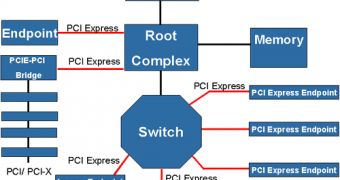For about 10 years, the main interface for PC compatible computers has been the old PCI standard interface. It was designed and produced to replace the even older ISA standard that was reaching its limits. Now we see the PCI cards reaching and hitting the limits of this interface, while a new standard is on its way of being adopted by the industry and the consumers.
The usefulness of an interface between various computer components is determined by the amount of data than can be transported through it (in computer language it is called "bandwidth"). The more data can be transported, the more useful the interface is. This is the exact limitation of the PCI standard that PCI Express was designed to solve. Using the current PCI standard a 32-bit bus has a maximum throughput of 133MB/s. This throughput of 133MB/s must be shared between all components that use the PCI standard. To keep the graphics cards from using up all the available bandwidth, the AGP standard was developed and used. For a while, it was enough but not when using SATA drives and gigabit Ethernet devices; then, computers quickly hit the 133MB/s limit. This is the exact spot where PCI Express comes into play as in its current revision it enables a single device to receive as much as 16GB/s of data. Future revisions are expected to have even higher bandwidth.
The PCI Express interface allows for an interface card to negotiate the number of lanes that it can communicate with the rest of the system. Each lane is comprised of 4 pins. A 1x card slot uses a single data lane, while an 8x adapter has eight total data lanes. This determines the total amount of bandwidth available to the peripheral. Most early PCI Express systems will ship with a single 16x PCI Express card slot for a graphics card and several 1x slots (usually between one and three). A single 1x card slot has the possible bandwidth of 500MB/s, higher than the current shared PCI bus. The 16x slot has the possible bandwidth of 8GB/s in both directions or 4GB/s in one direction. This is about twice the 2.1GB/s bandwidth of the AGP 8x standard.
Other benefits of the new PCI Express standard are the support of hot swapping devices, multiple linking between devices, a lower power consumption, while permitting a higher wattage for graphics cards.

 14 DAY TRIAL //
14 DAY TRIAL //